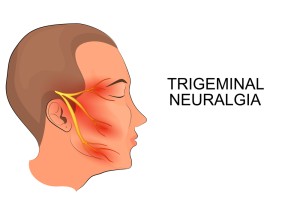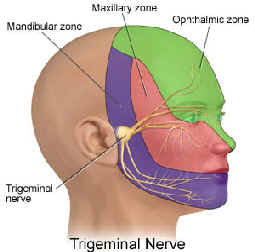Trigeminal Neuralgia – What is it? What can you Do?
 Neuralgia, also called nerve pain, is defined as pain that follows the pathway of a nerve.
Neuralgia, also called nerve pain, is defined as pain that follows the pathway of a nerve.
It can have many different causes. Sometimes, a “primary external agent” or cause at a particular site along the nerve pathway can be identified. Chemicals, inflammation, compression of tissues, tissue damage from accident or surgery (including dental surgery), and tumors all can cause nerve pain.
The human face has two trigeminal nerves, one on each side. Each nerve splits into three branches, which transmit sensations of pain and touch from the face, mouth, and teeth to the brain. It is the fifth cranial nerve and contains both sensory and motor nerves. There are 3 branches of the trigeminal nerve: the ophthalmic, maxillary, and mandibular. It supplies sensations to the face, and certain motor functions such as biting, chewing, and swallowing.
Trigeminal neuralgia, damage to this nerve, causes facial pain. Trigeminal neuralgia develops in mid to late life. The condition is the most frequently occurring of all the nerve pain disorders.
The pain, which comes and goes, feels like bursts of sharp, stabbing, electric shocks. This pain can last from a few seconds to a few minutes. The pain occurs almost exclusively in the maxillary (along the cheekbone, most of your nose, upper lip, and upper teeth) and mandibular area (the lower cheek, lower lip, and jaw). In almost all cases (97%), pain is restricted to one side of the face.
It is sometimes called “tic douloureux” due to the characteristic muscle spasm that accompanies the pain.
This intermittent severe pain interferes with common daily activities such as eating and sleeping. There is always the fear of unpredictable, painful attacks, which leads to sleep deprivation and under-eating. The condition can lead to irritability, severe anticipatory anxiety, and depression. It can lead to life-threatening malnutrition. Suicidal depression is not uncommon.
Doctors usually cannot find any disease of the trigeminal nerve or the central nervous system.
Cases in younger women are usually linked to damage to the nervous system.
 Trigeminal Neuralgia Causes
Trigeminal Neuralgia Causes
The condition has no clear-cut cause.
Some experts argue that the syndrome is caused by traumatic damage to the nerve as it passes from the openings in the skull to the muscles and tissue of the face. The damage compresses the nerve, causing the nerve cell to shed the protective and conductive coating, called demyelination.
Some believe the cause stems from biochemical changes in the nerve tissue itself.
Some believe that an abnormal blood vessel compresses the nerve as it exits from the brain itself.
All agree that an excessive burst of nervous activity from a damaged nerve causes the painful attacks.
Trigeminal Neuralgia Symptoms
A defining feature of trigeminal neuralgia is the trigger zone-a small area in the central part of the face, usually on a cheek, nose, or lip, that, when stimulated, triggers a typical burst of pain.
A light touch or vibration is the most effective trigger. Because of this, many common daily activities trigger the attacks, such as washing your face, brushing your teeth, shaving or talking. It can be caused by wind hitting your face or eating and chewing.
Many people avoid food and drink rather than experience the severe pain. It can then lead to weight loss and dehydration.
Between attacks, most people remain relatively pain-free. Some people, however, experience a dull ache between attacks, suggesting physical compression of the affected nerve, either by a blood vessel or some other structure.
Neuropathic Pain
Neuralgia often develops into a condition called neuropathic pain. When neuralgia becomes chronic, it can cause deterioration of the myelin sheath that surrounds and insulates pain nerves.
Then, just like an electrical circuit with exposed wiring, nerves that shouldn’t be communicating directly with each other cross paths and create a feedback loop that perpetuates pain.
What can be done?
RECOMMENDED:
Trigeminal Neuralgia Treatments and Natural Pain Relievers:
Pain Relief:
Dr. Gorgon Ko describes several case studies of chronic pain in the February 2010 “Clinical Journal of Pain.” Five patients with neuropathic pain experienced lasting relief by taking high dosages of EPA and DHA. Dosages of 2,400 to 7,200 mg a day contributed to improvements that were maintained for as long as 19 months.
It then follows that the higher the Omega-3 (EPA & DHA) content of the fish oil, the more it will nutritionally support and help your body to maintain normal nerve function.
See: Cold Water Fish Oil
What can be done for relief?
Treatment for this Nerve Damage
There are many medications and other remedies to bring relief, you can read it in this article, Neuropathy Treatments
RECOMMENDED
What can you do?
None of the various neuropathy treatments will build healthy nerves. You can cover up the symptoms, and you can increase circulation and you can make a person feel less pain, etc., but if you build healthy nerves, there will not be any symptoms (healthy nerves don’t hurt, tingle, burn, are not numb, etc.) and the relief will be lasting.
Rebuilding Healthy Nerves*
Healthy sensory nerves mean that they are not painful. Healthy nerves means that they communicate and don’t send wrong signals, such as burning, hot and cold, tingling when there is no reason for it. Healthy motor nerves mean that they relay messages from the brain to the muscle so that they move correctly. Nerves need to be healthy to function properly.
The body needs specific nutrients (vitamins) to be able to build healthy nerves.
It may not give immediate relief (although many do feel changes in the first week) as the vitamins are working at a cellular level, but it does address the actual problem, builds healthy nerves and brings lasting relief.
(For temporary relief while building healthy nerves, go to Pain Relief Formula )
What can be done for lasting relief?
Find out how to Build Healthy Nerves
*Studies & Research on Nerve Health
Want to Know More About Neuropathy?
Neuropathy Information Hub
Sign up to receive the MCVitamins Newsletter!
Up-to-date info on the latest health-related news happening in the world
(available in English only)

